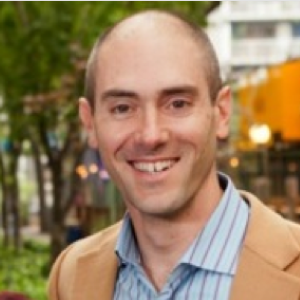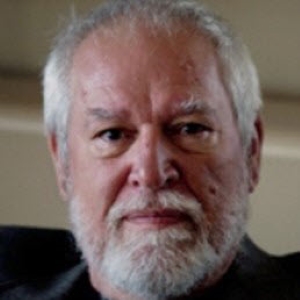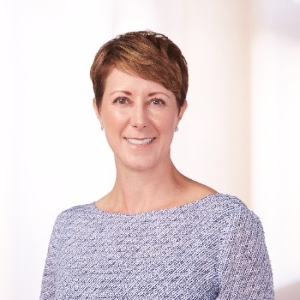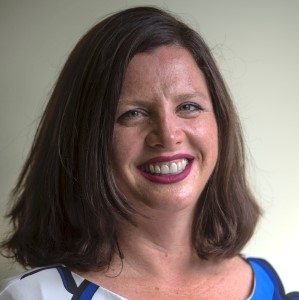Danielle Applestone: Think of a crop farm. Plenty of land with good rich soil. A tractor or two. Maybe a cultivator, seeder, sprayer, a combine harvester. With the right formula, fingers crossed, of sun and rain and temperature, and with the farmer’s eye ever fixed on the sky and what it might bring, hoping for a bountiful harvest.
Well today, there’s a very different type of farm taking shape. What sets this one apart is what it doesn’t have. No tractors. No traditional equipment. No weeds. No outdoors, and hence, no weather. Oh, and no soil. This farm trades the bucolic countryside for a warehouse like this one in an industrial park in New Jersey. This is a vertical farm with level upon level of leafy greens towering towards the ceiling. As you’re about to hear, with the help of technology, they’re grown with up to 95% less water, no pesticides, and as much as 390 times the productivity per square foot compared to a traditional field farm. You get the feeling we’re not in Kansas anymore.
I’m Danielle Applestone, engineer, entrepreneur, and long ago helper in my mother’s garden, where our idea of vertical farming was sugar snap peas and a trellis from the hardware store. This is Technology Powers X. In this episode, technology powers sustainable agriculture.
The first thing you notice about AeroFarms is its location in Newark, part of the New York-Newark-Jersey City metropolitan area, the most populated chunk of land in America. Where better to make a point that vertical farming may hold the key to sustainably feeding vast 21st century urban populations.
From the beginning, technology has been intertwined with American agriculture. But this is a whole new prospect. This is the farm growing up. David Rosenberg is CEO of AeroFarms.
David Rosenberg: We stack level upon level of growing. So typically, in a modern warehouse that has 50 feet high ceiling heights, we’ll pack in 12 or so levels of growing plants. I say 12 or so because it depends on what plants we’re growing. Some plants are taller, some plants are shorter, but 12 is about what we could fit in a 50 foot high ceiling height with leafy greens.
Danielle Applestone: To AeroFarms co-founder and Chief Marketing Officer, Marc Oshima, this adds, literally, a new dimension to conventional farm thinking.
Marc Oshima: So this is all of a sudden thinking about growing per cubic foot, no longer the square foot. What’s exciting is that we’ve grown over 800 different types of crops, and the idea that we can have a major impact in so many different areas of agriculture. Today, our commercial farms are actually focused and been optimized for short stem and leafy greens and herbs. It’s where we have some of the biggest advantages. We are able to grow that exact same product that, out in the field, may take 30 to 45 days to grow, we can grow in 12 to 14 days. How? By using technology. By understanding what the plant needs. We really think of ourselves as the plant whisperer, giving the plants exactly what they need, when they need it, to optimize their growing process.
Danielle Applestone: To David Rosenberg, part of the genius of urban indoor farming is that it removes the constrictions of time, seasons, and distance to market.
David Rosenberg: There are trends towards fresh food. People want fresh food. People also want food 365 days a year, and a lot of plants are very sensitive to temperature, humidity, seasonality. So a lot of our food comes from far away places. Then we also have to, as a consequence, harvest not when it’s ripe, so by the time it gets to its destination, it’s ready to be eaten.
David Rosenberg: It’s not an ideal way of managing the supply chain and growing plants. Sometimes, again for that 365 day demand, we have to grow further and further away. So at AeroFarms, we control temperature, humidity, all of the environmental conditions, enabling local food production at scale. Whether local is on the equator or in the North Pole, we could create the environmental conditions that are right for the plant.
Danielle Applestone: So far, AeroFarms has been able to grow over 800 different varieties of food from leafy greens to fruits, to vine and root crops. While that crop grows for a few minutes, come with me and I’ll show you how vertical farming first came to be.
Danielle Applestone: This is Columbia University, 22 miles away and about 20 years ago. It was here that the concept of vertical farming was first germinated. Dixon Despommier was teaching a course called medical ecology at Columbia University’s School of Public Health and School of Medicine. His graduate students wanted to work on a rooftop gardening project to see how many could be fed from the flat tops of Manhattan buildings. After six weeks of study, they determined that such gardens could only help feed 2% of Manhattan, woefully short of the sustainability they had hoped for. That’s when Professor Despommier, now retired, had a moment of epiphany.
Dickson Despommier: That last day, when they got so depressed, I turned to them and said, imagine what your idea would be like if we could take the farm on the roof and move it inside the building itself. That’s when I thought, at least in my mind, the idea of vertical farming occurred to me. I had never thought about it before.
Danielle Applestone: Professor Despommier is quick to add that many others would help develop the idea.
Dickson Despommier: Farming 12,000 years ago didn’t exist. 10,000 years ago, it barely existed. Today it occupies a land mass, if you added it all up together, it would be larger than the continent of South America. Now, in the meantime, of course, we’ve had to replace nature with farms. For the most part Europe and the United States and Canada have cleared hardwood forests to make room for crops. What that has done is to short circuit the earth’s perhaps 400 million year old solution to carbon sequestration because trees are made out of carbon. Solid carbon. In fact, their weight can be measured in tons of carbon because their trunks are so dense.
Danielle Applestone: As you can imagine, growing crops indoors without sun and soil requires a number of workarounds. One is the use of hydroponics, a concept developed in the 1930s, but whose idea is much older. Another is adding nutrients through fertilizers. That leaves the issue of light.
Dickson Despommier: Well, let’s start out with incandescent lights, and of course they didn’t work out too well. They’re only 5% efficient and they generate more heat than they do light. Then we switched to fluorescent lights back in the 1990s, and that was a big improvement. We got less heat and more light.
Danielle Applestone: And it was good. But then came a lighting technology that changed everything. David Rosenberg.
David Rosenberg: The enabler for vertical farming was the cost points of LEDs, light-emitting diodes. As the CAPEX the operating cost, the efficiency of a diode improved. That enabled our industry. So before that, whether it’s high pressure sodium or candescent lights, the economics, there was so much waste heat that the economics didn’t work. The life cycle of the bulb didn’t work. So now, an LED, even when we started, would last the attenuation, which means the life of that LED went from four years to eight years, and the efficiency really improved. So we’re innovating along that, and with LEDs, we could really separate the different spectrum of light.
David Rosenberg: Plants, it turns out, don’t need a lot of the spectrum, like yellow spectrum, which really adds a lot of the heat load of the diode of the luminaire. So we’re able to really give the plants what they want, which is mostly reds and blues, which are also a cooler spectrum, meaning they don’t burn as much heat. So we don’t have as much waste heat, as much as waste energy. So as LEDs, then the economics, and the innovation around LEDs improved, that enabled vertical farming.
Danielle Applestone:It was the quest for sustainability that inspired AeroFarms to explore a way to farm with neither hydroponics nor soil. Their solution was something called aeroponics, using a reusable growing medium that requires less water than hydroponics and field farming. Marc Oshima.
Marc Oshima: The circular economy is a big part of our ethos. How do we do more with less. Our growing medium, it’s actually a reusable medium, and it’s made out of recycled plastic. We’re taking water bottles out of the waste stream, and we’re converting it into a reusable growing medium that is also taking waste and turning it into something green and productive. So we’re able to use that cloth multiple times.
Marc Oshima: So just to paint the picture, we’re able to plant the seed on the cloth. We start the germination process. We’re able to accelerate. We’re able to trick that seed into that initial growing process. So what, out in the field, may take five to seven days, we can actually do within hours and start that growing process. Then it goes into our growing system and we’re delivering the optimal nutrients, light. But there’s other variables. There’s air. There’s temperature. There’s CO2. We’re putting together a holistic approach in terms of how we’re capturing data, to be able to optimize the plants.
Danielle Applestone: That holistic approach permeates the entire corporate culture of AeroFarms, whose very buildings are, in a sense, recycled.
Marc Oshima: One of the best ways to imagine what AeroFarms is doing with indoor vertical farming is thinking about converting warehouses. And each one of our farms actually has a different story about how we’ve been able to repurpose abandoned buildings. If you think about here in the US where a lot of manufacturing has disappeared, we’re able to breathe new life back into these buildings. So each one of our farms has a different story. We’ve been able to convert something that was part of the Ballantine Brewery. We’ve been able to convert something that was formally a steel mill. We were able to convert something that was formerly a nightclub. It’s all about how do we create the perfect environment for the plants?
Danielle Applestone: Growing food without the influences of sun, soil, and weather, means vertical farmers must control the growing process. That’s a challenge AeroFarms meets with data and technology. Seeding is automated, while data and analytics guide and optimize every step of the plant’s growth. David Rosenberg.
David Rosenberg: Plants have different needs for nutrients, micronutrients, spectrum, intensity, frequency, temperature, humidity, all these features. And there’s incredible specificity and controls in vertical farming at AeroFarms. So for example, most farmers in leafy greens, you seed, you put in nutrients, and then you re-water several times before harvest. That’s typically a 40 day span. Here, our plants are grown in 14 days, on average. Sometimes as little as four days. And our nutrients and micronutrients aren’t just once, right when seeding, but we re-nutrient every 15 minutes, and we make adjustments depending on what the uptake is of the root structure.
Danielle Applestone: The sustainability benefits of vertical farming have moved AeroFarms beyond the experimental to make them a full-blown commercial enterprise.
David Rosenberg: I’m a big believer that commerce, business, is the fastest route to change the world because if the economics of a business make sense, our impact as a business, as a businessman, could be bigger. It can scale faster and can have, therefore, greater and greater impact.
Danielle Applestone: One such impact is in the company’s minimal need for water, especially compared to conventional farming. Marc Oshima.
Marc Oshima: 70% of freshwater in the world goes to agriculture. 70% of the pollution of our freshwater is coming from agriculture due to the overuse of pesticides and fertilizers. So we’re able to grow in a much more efficient way. When we talk about the aeroponics, we’re actually misting the roots. So it’s not a sprinkler system that you have a lot of dehydration or evaporation in the air. We’re talking about targeting right to the roots, exactly, and we’re looking even down to the micron size. How to enhance that absorption of the water and the nutrients to optimize the growing situation for the plants. So we’re leveraging technology to think very specifically around our most precious resource, around water.
Danielle Applestone: Another benefit is proximity. Conventional produce might travel thousands of miles over several days to get to market. City grown crops get to market fast with a much smaller carbon footprint.
Marc Oshima: So within 24 hours, the product is harvested and delivered to major supermarkets, to major food service companies. This is really the next stage of just in time growing, and what we think is going to be the norm for the future.
Danielle Applestone: The thread that runs through this vertical farming operation is digitization. Data taken from the warehouse farm informs R&D, sales, marketing, operations, quality assurance, and food safety. At first, AeroFarms embraced the mantra, “big info, big data”. When that began to feel expensive, the mantra evolved to “smart data”. David Rosenberg embraces the idea of disruptive innovation, but he understands the turbulence that comes with any challenge to conventional thinking. And so does Professor Despommier.
Dickson Despommier: Remember, this is an industry that’s only seven years old. So people who criticize it and say, “vertical farming is not natural.” Well, P.S., neither is outdoor farming. Try to look around the world to find any natural system that makes only one thing when it grows.
Danielle Applestone: What is natural for David Rosenberg is the need to choose partners whose products and whose culture embrace sustainability.
David Rosenberg: An example of an integrated technology solution is the Dell rugged laptops. So you could imagine people walking around in a farm trying to capture information and take notes real time, share it with others, and things sometimes fall. So the rugged nature of some of the hardware is important. This is one example of where we’ve been able to partner with people to have smart solutions.
Danielle Applestone: Marc Oshima agrees.
Marc Oshima: When we think about partnerships at AeroFarms, what’s really important is that we think about companies that have shared vision, shared values. Dell has been a great partner in thinking about the environment, thinking about sustainability, and thinking about broader impact within the community.
Danielle Applestone: The shared vision and values resonates strongly with Page Motes, Dell Technology’s director of sustainability.
Page Motes: Our new 2030 social impact goals have several pillars. The advancing sustainability pillar clearly is the one that fits in my wheelhouse. Within that pillar, there are three things. Accelerating the circular economy, protecting the planet, and championing the many people who build our products. Within those three themes, there’s a series of goals. But innovation has to be at the heart of all of those. It is really exciting to see that AeroFarms is not only addressing the global food crisis, they’re innovating in this space. That Dell gets to be their technology partner, it’s quite an honor for us.
Danielle Applestone: That “make the world better philosophy”, which drives AeroFarms corporate culture, extends also to its place in the community and to the people it hires.
David Rosenberg: I’m very proud that we recently received, a few months ago, an award by the state of New Jersey, Governor Murphy, for our work with the New Jersey re-entry program. In the US, we have a big problem in recidivism, meaning that people come out of jail and then they go back to jail. Here, I personally believe you pay your debt to society, society should take someone back. So after someone pays their debt, serves their time in jail, we’ve been able to look past that and give people opportunities at AeroFarms and have had great success promoting people that come from the re-entry program. That’s something we will continue doing as we find other ways to inspire people in our communities, to certainly feed people in our communities, and have a stronger impact. Again, not just environmentally, not just through shareholder economics, but also impacting our communities from a societal standpoint.
Danielle Applestone: When Stacy Flanagan first visited AeroFarms and met the team, she quickly saw the value of the sustainability it brought to the community. She’s Director of Health and Human Services for Jersey City.
Stacey Flanagan: We have been working with AeroFarms to create vertical farming platform across Jersey City. We’re looking to install 10 farms in every neighborhood. This is with, one, city funding and grant dollars that are integral into many of the programs that we already have doing nutrition education, but doing more personal touch. So when you become a member, or you want to register to pick up an AeroFarm in your neighborhood, AeroFarm Greens. We’re going to be growing a series of different nutrient dense greens.
Danielle Applestone: As citizens since gradually warm to the idea of vertical farming, Stacy Flanagan sees a clear benefit.
Stacey Flanagan: I think it’s two fold. Some are thinking, this is a great idea. We can bring 20,000 pounds of greens. That’s about 60 to 65,000 servings of greens in the community. Some people feel like we should be investing more in community gardens. Community gardens can’t grow that quickly. And some soil is just not right to grow on in our community. So I think we’re getting both sides. I think we have a lot more excitement behind, “There’s going to be an AeroFarm in my neighborhood. I want to check it out.” We’re growing things without soil. We’re growing things with air and water. We’re growing things with new technology that can make our city more resilient, and get more people food where they need it.
Danielle Applestone: Over the generations, the women and men who’ve teased crops from the earth have relied on a wide range of skills. The farmer is part horticulturalist, part mechanic, part economist, meteorologist, and philosopher. Now, as the needs of a hungry world are changing, so are farmers. The women and men of today’s tech driven vertical farms are also electrical engineers, lighting engineers, industrial engineers, PLC engineers, and data scientists. As likely to live in a downtown high rise as along a rural road. As likely to carry a transit pass as keys to a pickup. Today, as always, farmers feed cities. It’s just that now some are doing it from downtown.
This is Technology Powers X, an original podcast from Dell Technologies. For more information on Dell Technology’s Progress Made Real social impact program, please visit DellTechnologies.com/ProgressMadeReal. For more information on Dell Latitude laptops and 2-in-1s, please visit DellTechnologies.com/Latitude. And to learn more about this episode, our speakers, and to read the transcript, visit DellTechnologies.com/TechnologyPowersX. I’m Danielle Applestone. Thanks for listening.
 Dell Solutions with Intel®
Dell Solutions with Intel® David Rosenberg
Chief Executive Officer, Aerofarms
David Rosenberg
Chief Executive Officer, Aerofarms
 Marc Oshima
Chief Marketing Officer, Aerofarms
Marc Oshima
Chief Marketing Officer, Aerofarms
 Dickson Despommier
Professor Emeritus, Environmental Health Sciences, Columbia University
Dickson Despommier
Professor Emeritus, Environmental Health Sciences, Columbia University
 Page Motes
Strategy Leader, Sustainability, Dell Technologies
Page Motes
Strategy Leader, Sustainability, Dell Technologies
 Stacey Flanagan
Director of Health and Human Services, Jersey City, New Jersey
Stacey Flanagan
Director of Health and Human Services, Jersey City, New Jersey
